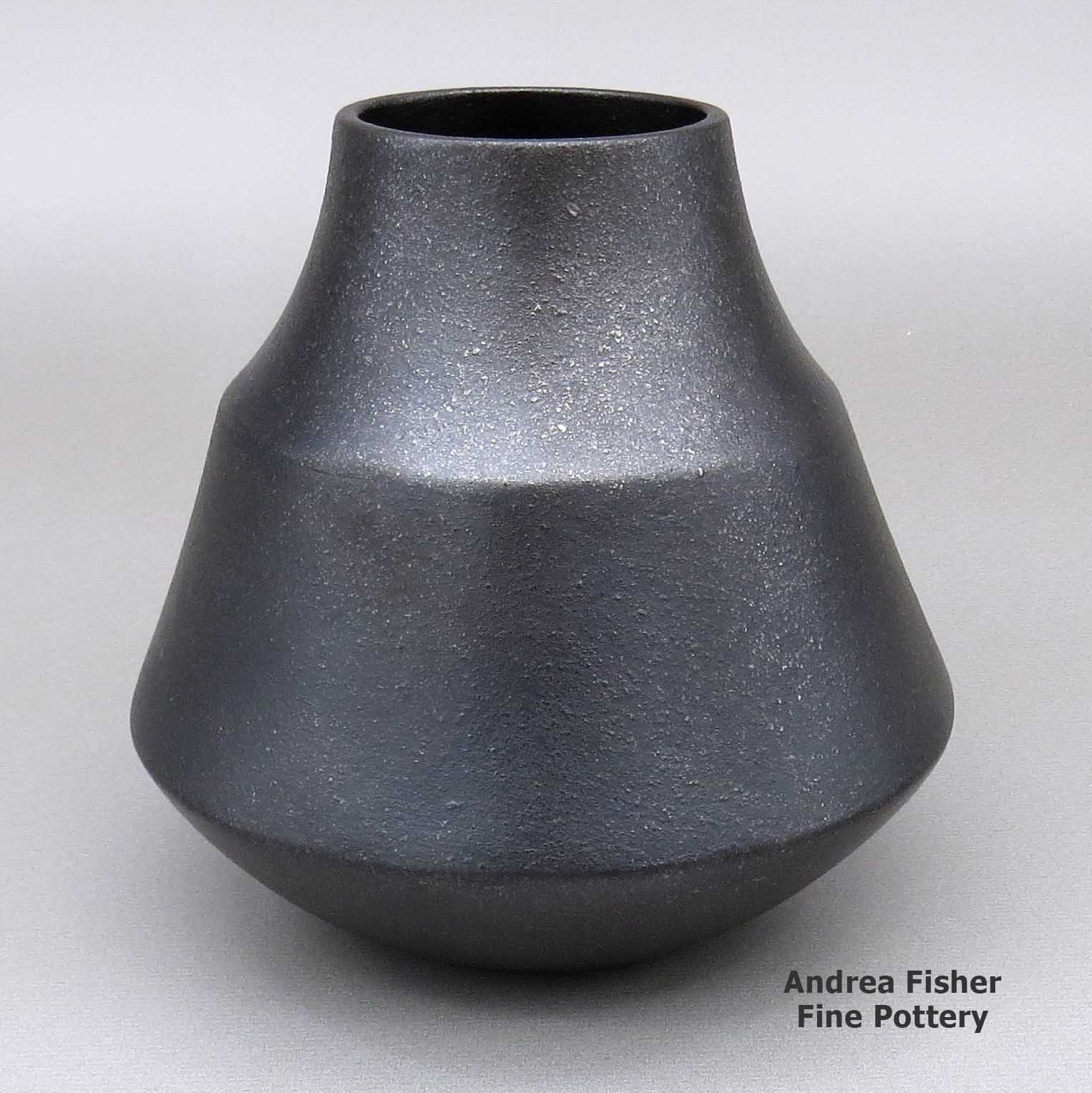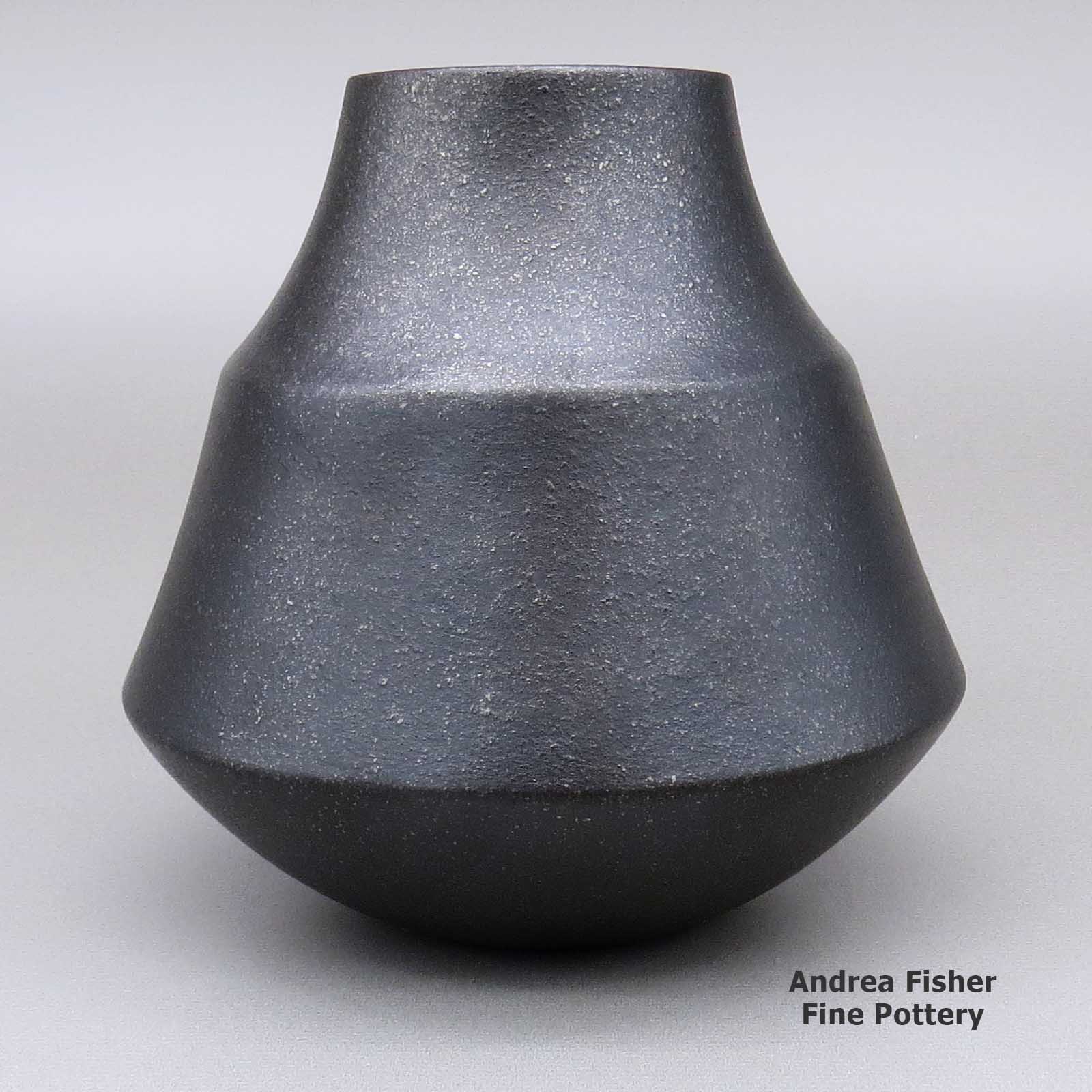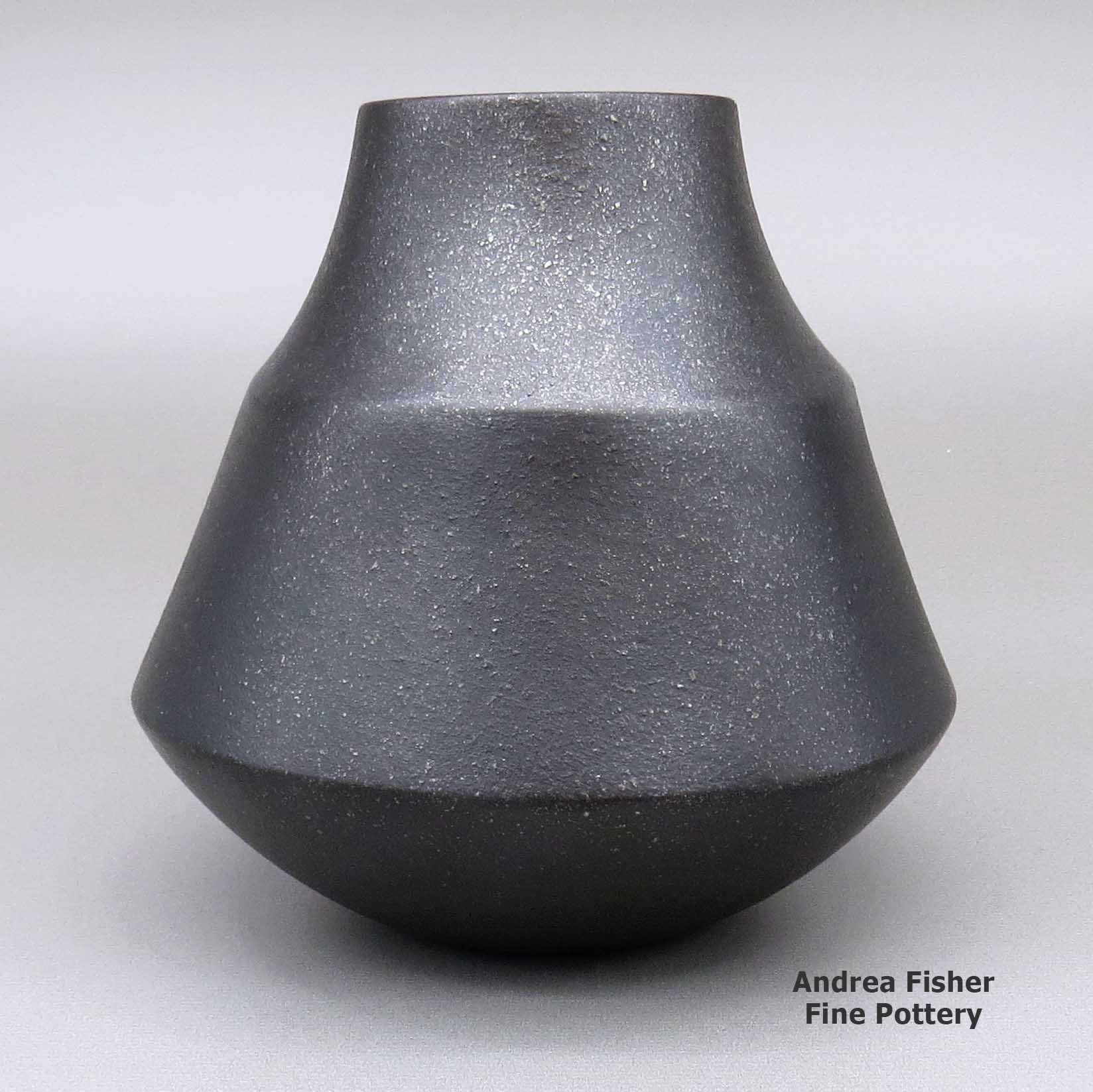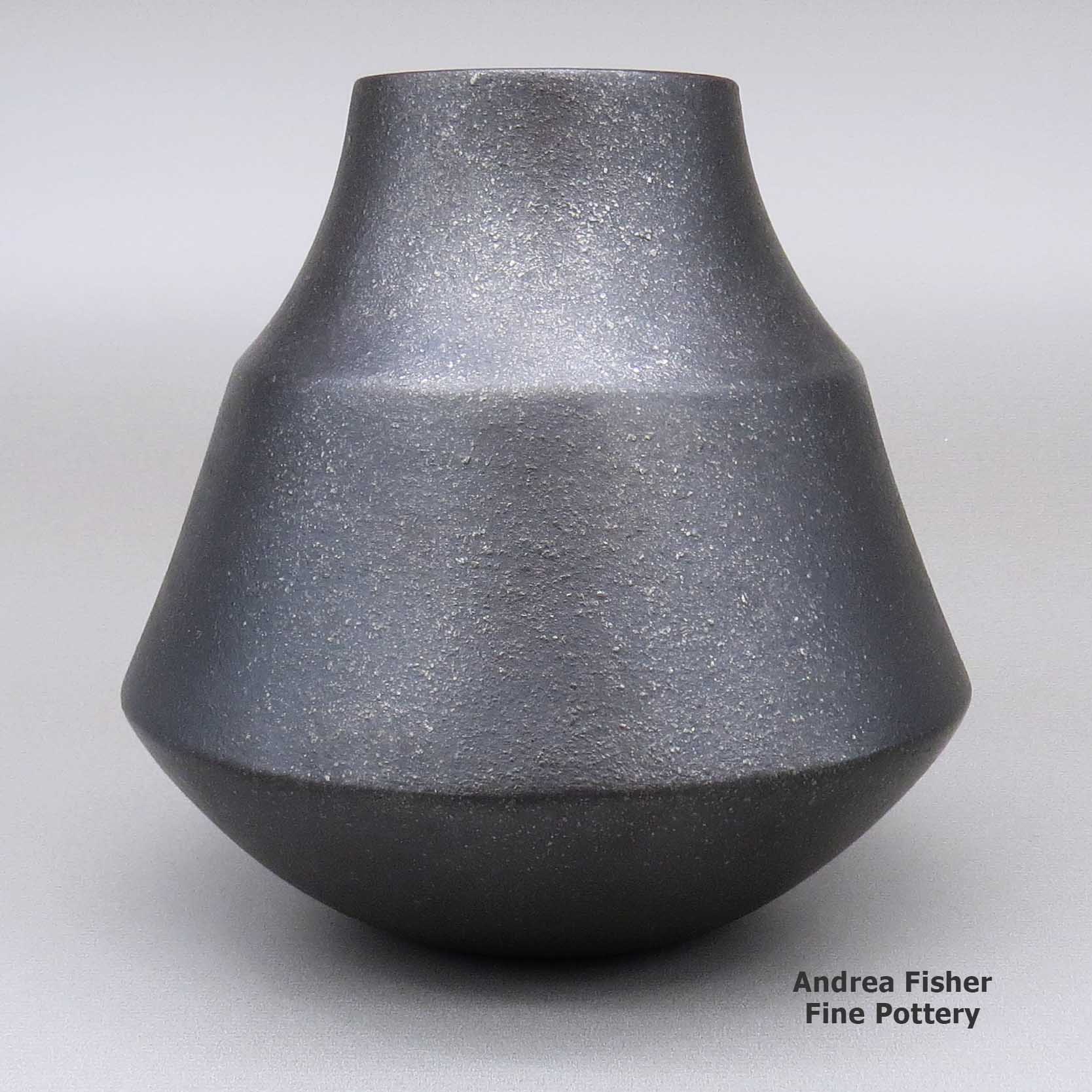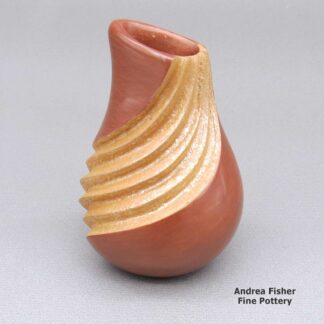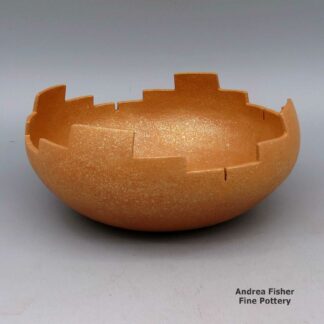| Dimensions | 5 × 5 × 5 in |
|---|---|
| Condition of Piece | Excellent |
| Date Born | 2023 |
| Signature | Robert Vigil Nambe |
Robert Vigil, zzna3a050, Micaceous black double shoulder jar
$265.00
A black micaceous double shouldered jar
In stock
Brand
Vigil, Robert
 "I just sit down and start and the clay forms itself through my hands."
"I just sit down and start and the clay forms itself through my hands."Half Nambe Pueblo and half Non-Pueblo, Robert Vigil was born to parents Joe and Alice Vigil in 1965. He first learned the method of making pots with clay coils while in high school in Texas. Then he returned to the pueblo and began to learn from folks like Virginia Gutierrez, his cousin Lonnie Vigil and then from Juan Tafoya of San Ildefonso Pueblo. Robert has been active as a Nambe potter since 1990 working with micaceous jars, bowls, vases, figures and polished redware.
Robert doesn't create giant storage jars like his cousin Lonnie. He much prefers to work on a smaller, more intimate scale. He colors his micaceous pots with fire clouds and other variations produced by the method of firing. There is an elegant purity to his simplistic and understated forms, a deep reflection of his soft spoken manner and gentle spirit.
Robert has told us he prefers the simple shapes and forms and even his carving is gentle. He gets his inspiration from the clay: "I just sit down and start and the clay forms itself through my hands." He's lately been teaching others at his pueblo how to make pottery the traditional way as he doesn't want to see that tradition get lost over time.
Robert has participated in shows at the Wheelwright Museum of the American Indian, at the Eight Northern Pueblos Arts and Crafts Show and at the First Micaceous Pottery Market and Symposium in 1995 in Santa Fe. Pieces of Robert's micaceous pottery are on display at the Minneapolis Art Institute in Minneapolis, MN, and at the Crocker Art Museum in Sacramento, CA, among others.
About Nambé Pueblo
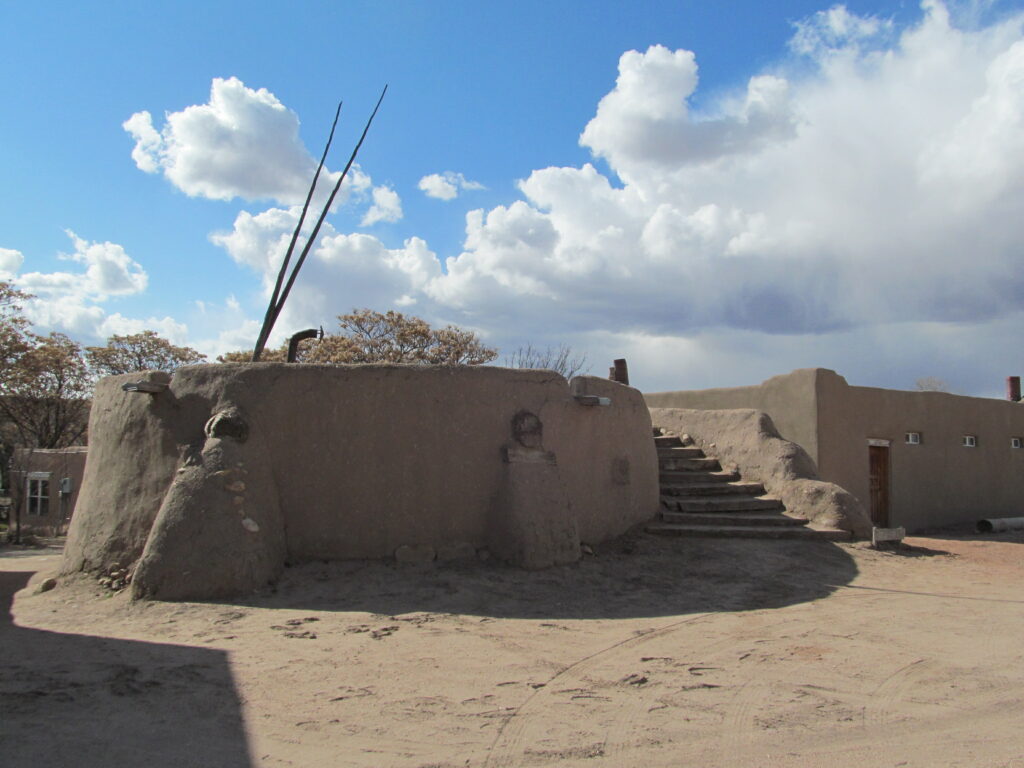
Nambé Pueblo was settled in the early 1300s when a group of Ancestral Puebloans (Anasazi) made their way from what is now the Bandelier National Monument area closer to the Rio Grande in search of more reliable water sources and more arable land.
At first they settled mostly high in the mountains, coming down to the river valleys in the summer to grow crops. Eventually, they felt safe enough to stay in the valleys and slowly abandoned the high mountain villages.
When the Spanish first arrived, Nambé was a primary economic, cultural and religious center for the area. That attracted a large Spanish presence and the nature of that presence caused the Nambé people to join wholeheartedly in the Pueblo Revolt of 1680 to throw out the Spanish oppressors.
When the Spanish returned in 1692, their rule was significantly less harsh. However, the Spanish brought horses into the New World and as the number of Spanish increased, so did the number of horses. That brought more and more raids from the Comanches as they came for horses and whatever else they could carry away. The Comanches were finally subdued by Governor Juan Bautista de Anza in 1776 but by then, the impact of European diseases was being strongly felt. A smallpox epidemic in the late 1820s virtually ended the making of pottery at Nambé.
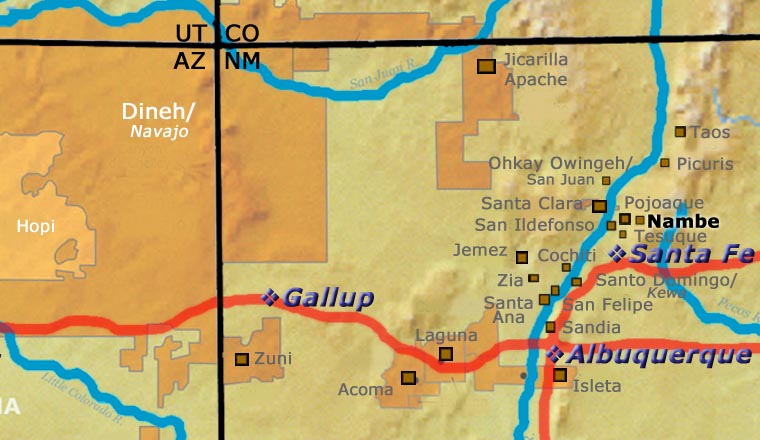
Photo courtesy of John Phelan, Creative Commons Attribution-Share Alike 3.0 Unported License
About Jars
The jar is a basic utilitarian shape, a container generally for cooking food, storing grain or for carrying and storing water. The jar's outer surface is a canvas where potters have been expressing their religious visions and stories for centuries.
In Sinagua pueblos (in northern Arizona), the people made very large jars and buried them up to their openings in the floors of the hidden-most rooms in their pueblo. They kept those jars filled with water but also kept smaller jars of meat and other perishables inside those jars in the water. It's a form of refrigeration still in use among indigenous people around the world.
Where bowls tend to be low, wide and with large openings, jars tend to be more globular: taller, less wide and with smaller openings.
For a potter looking at decorating her piece, bowls are often decorated inside and out while most jars are decorated only on the outside. Jars have a natural continuity to their design surface where bowls have a natural break at the rim, effectively yielding two design surfaces on which separate or complimentary stories can be told.
Before the mid-1800s, storage jars tended to be quite large. Cooking jars and water jars varied in size depending on how many people they were designed to serve. Then came American traders with enameled metal cookware, ceramic dishes and metal eating utensils...Some pueblos embraced those traders immediately while others took several generations to let them and their innovations in. Either way, opening those doors led to the virtual collapse of utilitarian pottery-making in most pueblos by the early 1900s.
In the 1920s there was a marked shift away from the machinations of individual traders and more toward marketing Native American pottery as an artform. Maria Martinez was becoming known through her exhibitions at various major industrial fairs around the country and Nampeyo of Hano was demonstrating her art for the Fred Harvey Company at the Grand Canyon. The first few years of the Santa Fe Indian Market helped to solidify that movement and propel it forward. It took another couple generations of artists to open other venues for their art across the country and turn Native American art into the phenomenon it has become.
Today's jars are artwork, not at all for utilitarian purposes, and their shapes, sizes and decorations have evolved to reflect that shift.
About Micaceous Pottery
Micaceous clay pots are the only truly functional Pueblo pottery still being made. Some special micaceous pots can be used directly on the stove or in the oven for cooking. Some are also excellent for food storage. Some people say the best beans and chili they ever tasted were cooked in a micaceous bean pot. Whether you use them for cooking or storage or as additions to your collection of fine art, micaceous clay pots are a beautiful result of centuries of Pueblo pottery making.
Between Taos and Picuris Pueblos is US Hill. Somewhere on US Hill is a mica mine that has been in use for centuries. Excavations of ancient ruins and historic homesteads across the Southwest have found utensils and cooking pots that were made of this clay hundreds of years ago.
Not long ago, though, the making of micaceous pottery was a dying art. There were a couple potters at Taos and at Picuris still making utilitarian pieces but that was it. Then Lonnie Vigil felt the call, returned to Nambe Pueblo from Washington DC and learned to make the pottery he became famous for. His success brought others into the micaceous art marketplace.
Micaceous pots have a beautiful shimmer that comes from the high mica content in the clay. Mica is a composite mineral of aluminum and/or magnesium and various silicates. The Pueblos were using large sheets of translucent mica to make windows prior to the Spaniards arriving. It was the Spanish who brought a technique for making glass. There are eight mica mining areas in northern New Mexico with 54 mines spread among them. Most micaceous clay used in the making of modern Pueblo pottery comes from several different mines near Taos Pueblo.
Potters Robert Vigil and Clarence Cruz have told us there are two basic kinds of micaceous clay that most potters use. The first kind is extremely micaceous, often with mica in thick sheets. While the clay and the mica it contains can be broken down to make pottery, that same clay has to be used to form the entire final product. It can be coiled and scraped but that final product will always be thicker and heavier but perhaps smoother on the surface. This is the preferred micaceous clay for making utilitarian pottery and utensils. It is essentially waterproof and will conduct heat evenly.
The second kind is the preferred micaceous clay for most non-functional fine art pieces. It has less of a mica content with smaller embedded pieces of mica. It is more easily broken down by the potters and more easily made into a slip to cover a base made of other clay. Even as a slip, the mica serves to bond and strengthen everything it touches. The finished product can be thinner but often has a more bumpy surface than a polished piece. As a slip, it can also be used to paint over other colors of clay for added effect. However, these micaceous pots may be a bit more water resistant than other Pueblo pottery but they are not utilitarian and will not survive utilitarian use.
While all micaceous clay from the area around Taos and Picuris turns golden when fired in the open air, that same clay can be turned black by firing in an oxygen reduction atmosphere. Black fire clouds are also a common element on golden micaceous pottery but they are more a result of smoke touching the piece in random bursts of air.
Mica is a relatively common component of clay, it's just not as visible in most. Potters at Hopi, Zuni and Acoma have produced mica-flecked pottery in other colors using finely powdered mica flakes. Some potters at San Ildefonso, Santa Clara, Jemez and Ohkay Owingeh use micaceous slips to add sparkle to their pieces. Hubert Candelario of San Felipe said he gets his micaceous clay somewhere along the La Bajada escarpment near Santo Domingo. The color of the clay indicates that Mark Wayne Garcia of Santo Domingo gets his micaceous clay in the same place.
Potters from the Jicarilla Apache Nation collect their micaceous clay closer to home, in the Tusas Mountains. The makeup of that clay is different and it fires to a less golden/orange color than does Taos or La Bajada clay. Some clay from the Picuris area fires less golden/orange, too. Christine McHorse, a Dineh potter who married into Taos Pueblo, used various micaceous clays on her pieces depending on what the clay asked of her in the flow of her creating. Juanita Martinez, a figure-maker from Jemez Pueblo married into and moved to Taos Pueblo. There, she began decorating her figures with bands and lines of micaceous slips.
There is nothing in the makeup of a micaceous pot that would hinder a good sgraffito artist or light carver from doing her or his thing. Some potters are also adept at adding sculpted appliqués to their pieces and slipping them with micaceous clay. There are some who have learned to successfully paint directly on a micaceous surface. The sparkly surface in concert with the beauty of a simple, well-executed shape is a real testament to the artistry of a micaceous potter.
Archaeologists and historians have long pointed at Taos and Picuris Pueblos as the birthplaces of micaceous pottery but at the 1994 Micaceous Pottery Symposium at the School for Advanced Research in Santa Fe, Jicarilla Apache potter Felix Ortiz advanced the possibility that the people of Taos and Picuris learned how to make micaceous pottery from the Jicarilla Apache people. After all, it is Jicarilla Apache pottery made of micaceous clay from the southern Sangre de Cristo Mountains area that has been found as far away as Dismal River Culture settlements in Colorado and Nebraska and proto-Kiowa settlements in the Black Hills of South Dakota.
